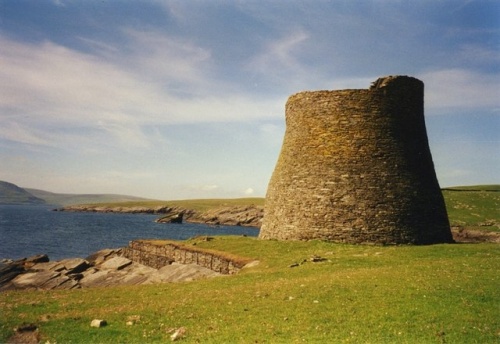
History
The broch was probably built around 100 BC, on the rocky shore looking over Mousa Sound. It stands 30 feet high, making it the tallest broch in the world and one of the best-reserved prehistoric buildings in Europe. It is the only broch to retain its full internal stair and to stand to its original height.
The reason that Mousa Broch has remained so well-preserved has to do with its unusual construction. Unlike most other brochs in Scotland, it has a small diameter, and the walls are much thinner. Yet despite the thin walls, the broch is very thick at the base, and the interior living area is quite small.
There is a single entrance, at ground level, with a 16 foot-long passage and a mural stair leading to a walkway at the top of the building. In the central space within the walls are a hearth and stone-lined tank set into the floor. Around the base of the wall is a stone bench, probably added after the broch was built.
There were two phases of occupation at Mousa; originally there was a timber roundhouse inside the broch walls, with its edges supported on a pair of low scarpment edges, and a series of timber posts set into the floor. At a later date the roundhouse was pulled down and replaced by a wheelhouse with a trio of projecting stone piers.
Within the thickness of the walls are three large chambers, or cells, entered by a threshold set about 3 feet above floor level. Each cell has stone cupboards, or recesses, built into the walls, and extra openings over the doorway lintel to allow air and light inside.

There are 6 galleries, accessed by a stair at the second level, and there is also a small cell over the entrance passage. To sum up all that description; the broch is an amazingly complex building, and it is remarkable just how much of it has survived intact.
The broch appears in two Norse sagas. The famous Orkneyinga Saga tells how the mother of Earl Harald Maddadsson was kidnapped and held at Mousa in 1153. Earl Harald besieged the broch to retrieve his mother from captivity. On another occasion a pair of lovers eloping from Norway were shipwrecked and used the broch for a temporary refuge.
The broch was visited by antiquarians in the 18th century and then, more famously, by novelist Sir Walter Scott in 1814. Scott rather exaggerated when he called it 'a Pictish fortress, the most entire probably in the world'.
Investigations inside the broch revealed a large number of animal bones, particularly otter. That doesn't necessarily mean the inhabitants ate a lot of otter, for archaeologists suggest that the otters may simply have used the broch after humans deserted it. Other objects found inside the broch include clay pots, a pot lid made of stone, and a small wooden model of a boat.
The broch is often used by storm petrels. Mousa is home to 6800 breeding pairs of petrels, and some make burrows inside the broch itself.
Access is only by the Mousa Ferry boat from Sandwick.
 We've 'tagged' this attraction information to help you find related historic attractions and learn more about major time periods mentioned.
We've 'tagged' this attraction information to help you find related historic attractions and learn more about major time periods mentioned.

